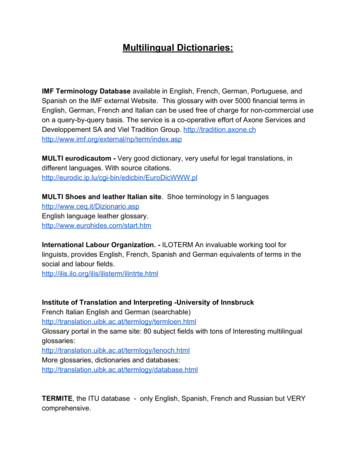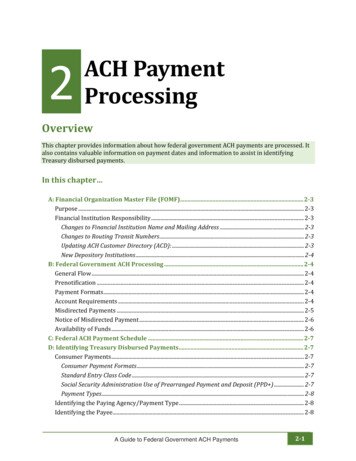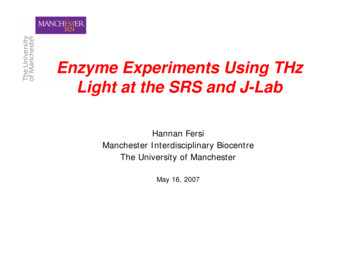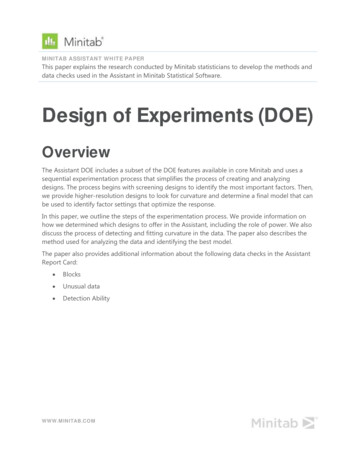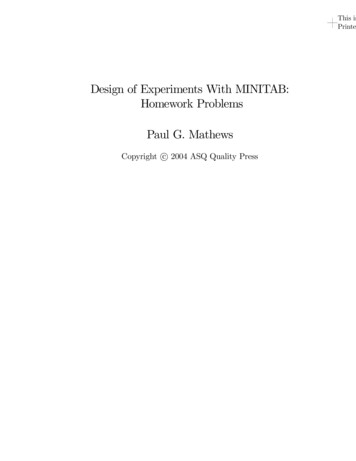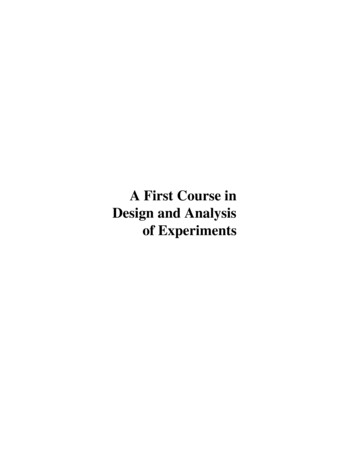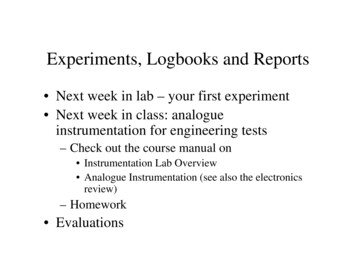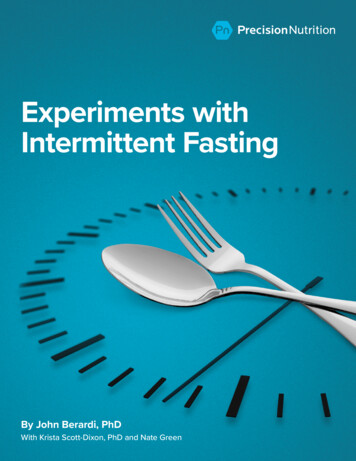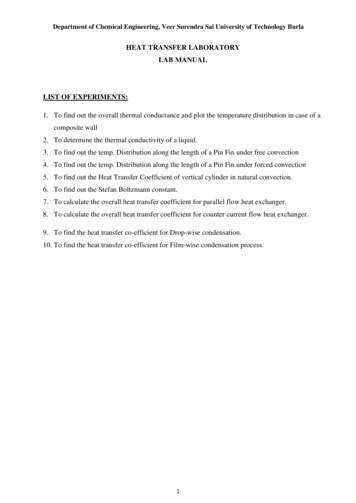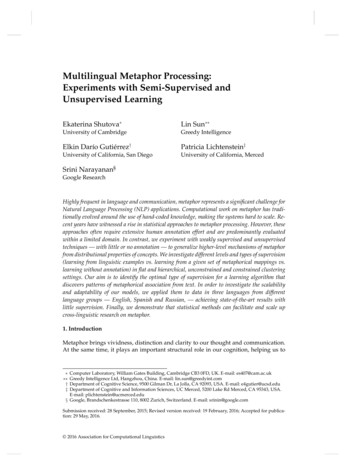
Transcription
Multilingual Metaphor Processing:Experiments with Semi-Supervised andUnsupervised LearningEkaterina Shutova Lin Sun University of CambridgeGreedy IntelligenceElkin Darío Gutiérrez†Patricia Lichtenstein‡University of California, San DiegoUniversity of California, MercedSrini Narayanan§Google ResearchHighly frequent in language and communication, metaphor represents a significant challenge forNatural Language Processing (NLP) applications. Computational work on metaphor has traditionally evolved around the use of hand-coded knowledge, making the systems hard to scale. Recent years have witnessed a rise in statistical approaches to metaphor processing. However, theseapproaches often require extensive human annotation effort and are predominantly evaluatedwithin a limited domain. In contrast, we experiment with weakly supervised and unsupervisedtechniques — with little or no annotation — to generalize higher-level mechanisms of metaphorfrom distributional properties of concepts. We investigate different levels and types of supervision(learning from linguistic examples vs. learning from a given set of metaphorical mappings vs.learning without annotation) in flat and hierarchical, unconstrained and constrained clusteringsettings. Our aim is to identify the optimal type of supervision for a learning algorithm thatdiscovers patterns of metaphorical association from text. In order to investigate the scalabilityand adaptability of our models, we applied them to data in three languages from differentlanguage groups — English, Spanish and Russian, — achieving state-of-the-art results withlittle supervision. Finally, we demonstrate that statistical methods can facilitate and scale upcross-linguistic research on metaphor.1. IntroductionMetaphor brings vividness, distinction and clarity to our thought and communication.At the same time, it plays an important structural role in our cognition, helping us to †‡Computer Laboratory, William Gates Building, Cambridge CB3 0FD, UK. E-mail: es407@cam.ac.ukGreedy Intelligence Ltd, Hangzhou, China. E-mail: lin.sun@greedyint.comDepartment of Cognitive Science, 9500 Gilman Dr, La Jolla, CA 92093, USA. E-mail: e4gutier@ucsd.eduDepartment of Cognitive and Information Sciences, UC Merced, 5200 Lake Rd Merced, CA 95343, USA.E-mail: plichtenstein@ucmerced.edu§ Google, Brandschenkestrasse 110, 8002 Zurich, Switzerland. E-mail: srinin@google.comSubmission received: 28 September, 2015; Revised version received: 19 February, 2016; Accepted for publication: 29 May, 2016. 2016 Association for Computational Linguistics
Computational LinguisticsVolume XX, Number XXorganise and project knowledge (Lakoff and Johnson 1980; Feldman 2006) and guidingour reasoning (Thibodeau and Boroditsky 2011). Metaphors arise due to systematic associations between distinct, and seemingly unrelated, concepts. For instance, when wetalk about “the turning wheels of a political regime”, “rebuilding the campaign machinery”or “mending foreign policy”, we view politics and political systems in terms of mechanisms,they can function, break, be mended, have wheels etc. The existence of this associationallows us to transfer knowledge and inferences from the domain of mechanisms to thatof political systems. As a result, we reason about political systems in terms of mechanismsand discuss them using the mechanism terminology in a variety of metaphorical expressions. The view of metaphor as a mapping between two distinct domains was echoedby numerous theories in the field (Black 1962; Hesse 1966; Lakoff and Johnson 1980;Gentner 1983). The most influential of them was the Conceptual Metaphor Theory(CMT) of Lakoff and Johnson (1980). Lakoff and Johnson claimed that metaphor is notmerely a property of language, but rather a cognitive mechanism that structures ourconceptual system in a certain way. They coined the term conceptual metaphor to describethe mapping between the target concept (e.g. politics) and the source concept (e.g.mechanism), and linguistic metaphor to describe the resulting metaphorical expressions.Other examples of common metaphorical mappings include: TIME IS MONEY (e.g. “Thatflat tire cost me an hour”); IDEAS ARE PHYSICAL OBJECTS (e.g. “I can not grasp his wayof thinking”); VIOLENCE IS FIRE (e.g. “violence flares amid curfew”); EMOTIONS AREVEHICLES (e.g. “[.] she was transported with pleasure”); FEELINGS ARE LIQUIDS (e.g.“[.] all of this stirred an unfathomable excitement in her”); LIFE IS A JOURNEY (e.g. “Hearrived at the end of his life with very little emotional baggage”).Manifestations of metaphor are pervasive in language and reasoning, making itscomputational processing an imperative task within NLP. Explaining up to 20% ofall word meanings according to corpus studies (Shutova and Teufel 2010; Steen et al.2010), metaphor is currently a bottleneck in semantic tasks in particular. An accurateand scalable metaphor processing system would become an important component ofmany practical NLP applications. These include, for instance, machine translation (MT):a large number of metaphorical expressions are culture-specific and therefore representa considerable challenge in translation (Schäffner 2004; Zhou, Yang, and Huang 2007).Shutova, Teufel, and Korhonen (2013) conducted a study of metaphor translation inMT. Using Google Translate1 , a state-of-the-art MT system, they found that as many as44% of metaphorical expressions in their dataset were translated incorrectly, resultingin semantically infelicitous sentences. A metaphor processing component could helpto avoid such errors. Other applications of metaphor processing include, for instance,opinion mining: metaphorical expressions tend to contain a strong emotional component (e.g. compare the metaphor “Government loosened its stranglehold on business”and its literal counterpart “Government deregulated business” (Narayanan 1999)); orinformation retrieval: non-literal language without appropriate disambiguation maylead to false positives in information retrieval (e.g. documents describing “old schoolgentlemen” should not be returned for the query “school” (Korkontzelos et al. 2013));and many others.Since the metaphors we use are also known to be indicative of our underlying viewpoints, metaphor processing is likely to be fruitful in determining political affiliationfrom text or pinning down cross-cultural and cross-population differences, and thusbecome a useful tool in data mining. In social science, metaphor is extensively studied1 http://translate.google.com/2
Shutova et al.Multilingual Metaphor Processingas a way to frame cultural and moral models, and to predict social choice (Landau,Sullivan, and Greenberg 2009; Thibodeau and Boroditsky 2011; Lakoff and Wehling2012). Metaphor is also widely viewed as a creative tool. Its knowledge projectionmechanisms help us to grasp new concepts and generate innovative ideas. This opensmany avenues for the creation of computational tools that foster creativity (Veale 2011,2014) and support assessment in education (Burstein et al. 2013).For many years, computational work on metaphor evolved around the use of handcoded knowledge and rules to model metaphorical associations, making the systemshard to scale. Recent years have seen a growing interest in statistical modelling ofmetaphor (Mason 2004; Gedigian et al. 2006; Shutova 2010; Shutova, Sun, and Korhonen2010; Turney et al. 2011; Mohler et al. 2013; Tsvetkov, Mukomel, and Gershman 2013;Hovy et al. 2013; Heintz et al. 2013; Strzalkowski et al. 2013; Shutova and Sun 2013;Li, Zhu, and Wang 2013; Mohler et al. 2014; Beigman Klebanov et al. 2014), with manynew techniques opening routes for improving system accuracy and robustness. A widerange of methods have been proposed and investigated by the community, includingsupervised classification (Gedigian et al. 2006; Mohler et al. 2013; Tsvetkov, Mukomel,and Gershman 2013; Hovy et al. 2013; Dunn 2013a), unsupervised learning (Heintz etal. 2013; Shutova and Sun 2013), distributional approaches (Shutova 2010; Shutova, Vande Cruys, and Korhonen 2012; Shutova 2013; Mohler et al. 2014), lexical resource-basedmethods (Krishnakumaran and Zhu 2007; Wilks et al. 2013), psycholinguistic features(Turney et al. 2011; Neuman et al. 2013; Gandy et al. 2013; Strzalkowski et al. 2013)and web search using lexico-syntactic patterns (Veale and Hao 2008; Li, Zhu, and Wang2013; Bollegala and Shutova 2013). However, even the statistical methods have beenpredominantly applied in limited-domain, small-scale experiments. This is mainly dueto the lack of general-domain corpora annotated for metaphor that are sufficiently largefor training wide-coverage supervised systems. In addition, supervised methods tendto rely on lexical resources and ontologies for feature extraction, which limits the robustness of the features themselves and makes the methods dependent on the coverage(and the availability) of these resources. This also makes these methods difficult to portto new languages, for which such lexical resources or corpora may not exist. In contrast,we experiment with minimally supervised and unsupervised learning methods, thatrequire little or no annotation; and employ robust, dynamically-mined lexico-syntacticfeatures, that are well suited for metaphor processing. This makes our methods scalableto new data and portable across languages, domains and tasks, bringing metaphorprocessing technology a step closer to a possibility of integration with real-world NLP.Our methods use distributional clustering techniques to investigate how metaphorical cross-domain mappings partition the semantic space in three different languages– English, Russian and Spanish. In a distributional semantic space, each word is represented as a vector of contexts in which it occurs in a text corpus2 . Due to the highfrequency and systematicity with which metaphor is used in language, it is naturallyand systematically reflected in the distributional space. As a result of metaphoricalcross-domain mappings, the words’ context vectors tend to be non-homogeneous instructure and to contain vocabulary from different domains. For instance, the contextvector for the noun idea would contain a set of literally-used terms (e.g. understand [anidea]) and a set of metaphorically-used terms, describing ideas as PHYSICAL OBJECTS(e.g. grasp [an idea], throw [an idea]), LIQUIDS (e.g. [ideas] flow), or FOOD (e.g. digest2 In our experiments we use a syntax-aware distributional space, where the vectors are constructed usingthe words’ grammatical relations.3
Computational LinguisticsN: game1170 play202 win99 miss76 watch66 lose63 start42 enjoy22 finish.20 dominate18 quit17 host17 follow17 control.Volume XX, Number XXN: politics31 dominate30 play28 enter16 discuss13 leave12 understand8 study6 explain5 shape4 influence4 change4 analyse.2 transform.Figure 1Context vectors for game and politics (verb–direct object relations) extracted from the BritishNational Corpus. The context vectors demonstrate how metaphor structures the distributionalsemantic space through cross-domain vocabulary projection.[an idea]) etc. Similarly, the context vector for politics would contain MECHANISM terms(e.g. operate or refuel [politics]), GAME terms (e.g. play or dominate [politics]), SPACE terms(e.g. enter or leave [politics]), as well as the literally-used terms (e.g. explain or understand[politics]), as shown in Figure 1. This demonstrates how metaphorical usages, abundantin the data, structure the distributional space. As a result, the context vectors of differentconcepts contain a certain degree of cross-domain overlap, thus implicitly encodingcross-domain mappings. Figure 1 shows such a term overlap in the direct object vectorsfor the concepts of GAME and POLITICS. We exploit such composition of the contextvectors to induce information about metaphorical mappings directly from the words’distributional behaviour in an unsupervised or a minimally supervised way. We thenuse this information to identify metaphorical language. Clustering methods modelmodularity in the structure of the semantic space, and thus naturally provide a suitableframework to capture metaphorical information. To our knowledge, the metaphoricalcross-domain structure of the distributional space has not yet been explicitly exploitedin wider NLP. Instead, most NLP approaches tend to treat all types of distributionalfeatures as identical, thus possibly losing important conceptual information that isnaturally encoded in the distributional semantic space.The focus of our experiments is on the identification of metaphorical expressionsin verb–subject and verb–object constructions, where the verb is used metaphorically.In the first set of experiments, we apply a flat clustering algorithm, spectral clustering(Ng et al. 2002), to learn metaphorical associations from text. The system clusters verbsand nouns to create representations of source and target domains. The verb clusteringis used to harvest source domain vocabulary and noun clustering to identify groups oftarget concepts associated with the same source. For instance, the nouns democracy andmarriage get clustered together (in the target noun cluster), since both are metaphoricallyassociated with e.g. mechanisms or games and, as such, appear with mechanism and gameterms in the corpus (the source verb cluster). The obtained clusters represent sourceand target concepts between which metaphorical associations hold. We first experimentwith the unconstrained version of spectral clustering using the method of Shutova, Sun,4
Shutova et al.Multilingual Metaphor Processingand Korhonen (2010), where metaphorical patterns are derived from the distributionalinformation alone and the clustering process is fully unsupervised. We then extendthis method to perform constrained clustering, where a small number of examplemetaphorical mappings are used to guide the learning process, with the expectation ofchanging the cluster structure towards capturing metaphorically associated concepts.We then analyse and compare the structure of the clusters obtained with or withoutthe use of constraints. The learning of metaphorical associations is then boosted froma small set of example metaphorical expressions, that are used to connect the verb andnoun clusters. Finally, the acquired set of associations is used to identify new, unseenmetaphorical expressions in a large corpus.While we believe that the above methods would capture a substantial amount ofinformation about metaphorical associations from distributional properties of concepts,they are still dependent on the seed expressions to identify new metaphorical language.In our second set of experiments, we investigate to what extent it is possible to acquire information about metaphor from distributional properties of concepts alone,without any need for labelled examples. For this purpose, we apply the hierarchicalclustering method of Shutova and Sun (2013) to identify both metaphorical associationsand metaphorical expressions in a fully unsupervised way. We use hierarchical graphfactorization clustering (HGFC) (Yu, Yu, and Tresp 2006) of nouns to create a network(or a graph) of concepts and to quantify the strength of association between conceptsin this graph. The metaphorical mappings are then identified based on the associationpatterns between concepts in the graph. The mappings are represented as cross-level,one-directional connections between clusters in the graph. The system then uses salientfeatures of the metaphorically connected clusters to identify metaphorical expressionsin text. Given a source domain, the method outputs a set of target concepts associatedwith this source, as well as the corresponding metaphorical expressions.We then compare the ability of these methods (that require different kinds andlevels of supervision) to identify metaphor. In order to investigate the scalability andadaptability of the methods, we applied them to unrestricted, general-domain text inthree typologically different languages – English, Spanish and Russian. We evaluatedthe performance of the systems with the aid of human judges in precision- and recalloriented settings, achieving state-of-the-art results with little supervision. Finally, weanalyse the differences in the use of metaphor across languages, as discovered by thesystems, and demonstrate that statistical methods can facilitate and scale up crosslinguistic research on metaphor.2. Related work2.1 Metaphor annotation studiesMetaphor annotation studies have typically been corpus-based and involved eithercontinuous annotation of metaphorical language (i.e. distinguishing between literaland metaphorical uses of words in a given text), or search for instances of a specificmetaphor in a corpus and an analysis thereof. The majority of corpus-linguistic studieswere concerned with metaphorical expressions and mappings within a limited domain,e.g. WAR , BUSINESS , FOOD or PLANT metaphors (Santa Ana 1999; Izwaini 2003; Koller2004; Skorczynska Sznajder and Pique-Angordans 2004; Lu and Ahrens 2008; Low etal. 2010; Hardie et al. 2007), or in a particular genre or type of discourse, such asfinancial (Charteris-Black and Ennis 2001; Martin 2006), political (Lu and Ahrens 2008)or educational (Cameron 2003; Beigman Klebanov and Flor 2013) discourse.5
Computational LinguisticsVolume XX, Number XXTwo studies (Steen et al. 2010; Shutova and Teufel 2010) moved away from investigating particular domains to a more general study of how metaphor behaves inunrestricted continuous text. Steen and colleagues (Pragglejaz Group 2007; Steen etal. 2010) proposed a metaphor identification procedure (MIP), in which every word istagged as literal or metaphorical, based on whether it has a “more basic meaning” inother contexts than the current one. The basic meaning was defined as “more concrete;related to bodily action; more precise (as opposed to vague); historically older” and itsidentification was guided by dictionary definitions. The resulting VU Amsterdam Metaphor Corpus3 is a 200,000 word subset of the British National Corpus (BNC) (Burnard2007) annotated for linguistic metaphor. The corpus has already found application incomputational metaphor processing research (Dunn 2013b; Niculae and Yaneva 2013;Beigman Klebanov et al. 2014), as well as inspiring metaphor annotation efforts in otherlanguages (Badryzlova et al. 2013). Shutova and Teufel (2010) extended MIP to theidentification of conceptual metaphors along with the linguistic ones. Following MIP,the annotators were asked to identify the more basic sense of the word, and then labelthe context in which the word occurs in the basic sense as the source domain, and thecurrent context as the target. Shutova and Teufel’s corpus is a 13,000 word subset ofthe BNC sampling a range of genres, and it has served as a testbed in a number ofcomputational experiments (Shutova 2010; Shutova, Sun, and Korhonen 2010; Bollegalaand Shutova 2013).Lönneker (2004) investigated metaphor annotation in lexical resources. Their Hamburg Metaphor Database contains examples of metaphorical expressions in German andFrench, which are mapped to senses from EuroWordNet4 and annotated with sourcetarget domain mappings.2.2 Computational approaches to metaphor identificationEarly computational work on metaphor tended to be theory-driven and utilized handcoded descriptions of concepts and domains to identify and interpret metaphor. Thesystem of Fass (1991), for instance, was an implementation of the selectional preferenceviolation view of metaphor (Wilks 1978) and detected metaphor and metonymy as aviolation of a common preference of a predicate by a given argument. Another branchof approaches (Martin 1990; Narayanan 1997; Barnden and Lee 2002) implementedsome aspects of the conceptual metaphor theory (Lakoff and Johnson 1980), reasoningover hand-crafted representations of source and target domains. The system of Martin
in the data, structure the distributional space. As a result, the context vectors of different concepts contain a certain degree of cross-domain overlap, thus implicitly encoding cross-domain mappings. Figure 1 shows such a term overlap in the direct object vectors for the concepts of GAME and POLITICS. We exploit such composition of the context
